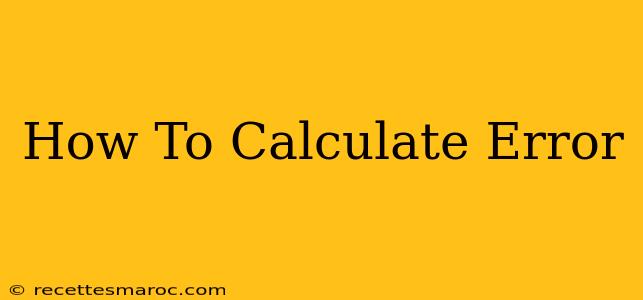Understanding and calculating error is crucial in various fields, from scientific research and engineering to business analysis and everyday life. This guide will walk you through different types of errors and how to calculate them, equipping you with the tools to analyze data accurately.
Types of Errors
Before diving into calculations, it's vital to understand the different types of errors you might encounter:
1. Absolute Error
This is the simplest type of error. It's the absolute difference between the measured value and the true or accepted value. The formula is:
Absolute Error = |Measured Value - True Value|
For example, if the true value is 10 and your measurement is 12, the absolute error is |12 - 10| = 2.
2. Relative Error
Relative error expresses the absolute error as a fraction or percentage of the true value. This provides a better understanding of the error's significance relative to the magnitude of the measurement. The formula is:
Relative Error = (Absolute Error / True Value) * 100%
Using the same example (true value = 10, measured value = 12), the relative error is (2 / 10) * 100% = 20%.
3. Percentage Error
This is simply the relative error expressed as a percentage, as shown in the relative error formula above. It's a common way to present error in many applications.
4. Standard Error
Standard error is a measure of the statistical accuracy of an estimate, especially of the mean. It quantifies the variability of the sample mean from the true population mean. A smaller standard error indicates a more precise estimate. The formula is:
Standard Error = Standard Deviation / √(Sample Size)
This requires calculating the standard deviation of your sample first.
5. Error Propagation
When calculations involve multiple measured values, each with its own error, error propagation methods determine the uncertainty in the final result. There are several techniques, including:
- Addition/Subtraction: The absolute errors add up.
- Multiplication/Division: The relative errors add up.
- More complex functions: Requires more sophisticated techniques involving partial derivatives.
Calculating Error in Practice
Let's look at some practical examples:
Example 1: Measuring Length
You measure the length of a table as 1.52 meters, but the actual length is 1.50 meters.
- Absolute Error: |1.52 - 1.50| = 0.02 meters
- Relative Error: (0.02 / 1.50) * 100% ≈ 1.33%
Example 2: Scientific Experiment
In a chemistry experiment, you expect a yield of 10 grams, but obtain 9.5 grams.
- Absolute Error: |9.5 - 10| = 0.5 grams
- Relative Error: (0.5 / 10) * 100% = 5%
Minimizing Errors
Understanding how to calculate error is only half the battle; minimizing errors is equally important. Here are some strategies:
- Use precise instruments: High-quality equipment leads to more accurate measurements.
- Repeat measurements: Taking multiple readings and averaging them reduces random errors.
- Control variables: In experiments, carefully control all variables except the one you're studying.
- Calibrate instruments: Regularly calibrate your equipment to ensure accuracy.
Conclusion
Calculating error is a fundamental skill across various disciplines. Mastering the different types of error and their calculation methods is crucial for accurate data analysis and informed decision-making. By understanding and minimizing errors, you can significantly improve the reliability and validity of your work. Remember to always consider the context of your measurements and choose the appropriate error calculation method accordingly.

